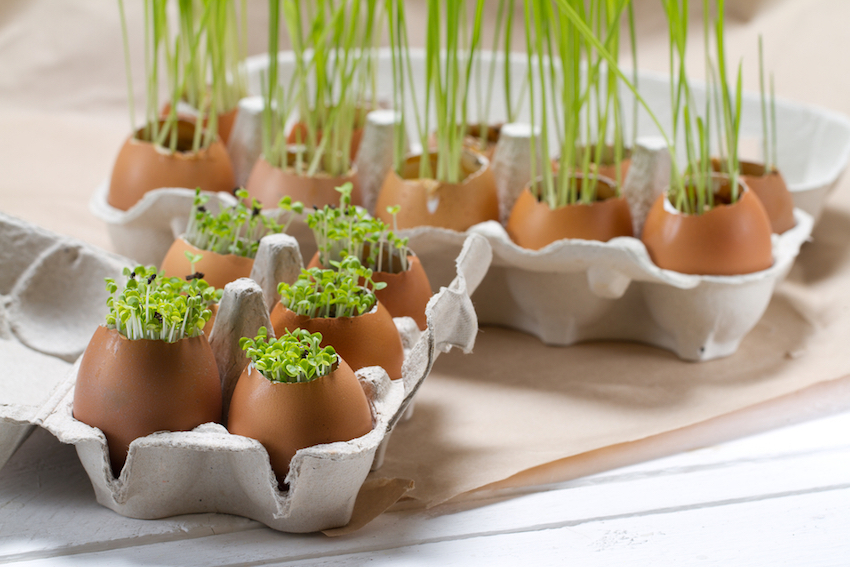
How To Grow Your Own Herbs On Your Kitchen Counter
It’s easier said than done to ensure our families have access to fresh veggies every day. Between busy work schedules, family, or space restraints, maintaining even indoor plants can be a daunting task. Daunting, maybe. Impossible, definitely not!
If you have access to a bright window, herbs can be grown all year long, right on your kitchen counter. Even if you don’t have the space or time to tend to a garden, growing your own herbs can be an easy and affordable way to spice and brighten up your daily meals.
There are so many ways to grow indoor plants these days – the high tech gadgets, lights, and monitors are pricier ways to ensure a green thumb, but they are certainly not the only way. In fact, growing seedlings straight from discarded egg shells is an easy and effective way to make sure your herbs get off to a great start. Here’s everything you need to know to start your eggshell garden.
How To Grow Eggshell Seedlings
What you’ll need:
Saved eggshell halves
Egg carton
Variety of herb seeds
A small enough spoon that fits into the eggshell
Sharp pin to pierce eggshell
Soil
Water and spray bottle
Instructions:
1. Set aside your used egg shell halves. To ensure a good break, using a very sharp knife, slice the top off the egg, reserving the bottom half. A clean break is not necessary, but you do want to ensure the egg cup is large enough to hold your soil and seedling. After pouring out the egg’s center, rinse well with hot water to clean and remove any residue that could rot or mold (including the membrane). Once cleaned, place them in the carton to dry.
2. Now you are ready to further prepare the egg for your herb seeds. Inspect your egg halves, gently chipping away the edges to create a larger opening, if needed. Using a sharp needle, create a small opening at the bottom center of the egg. This will act as drainage for your “planter”. This will also allow the roots to emerge once you’ve actually planted your mature seedling.
3. Spray the inside of each egg with water, and evenly spoon in soil until filled. Soil should be moist but not overly wet or muddy. Using the seed package directions as your guide, plant seeds as instructed and return egg shells to their carton and place in a well lit window.
4. Water plants daily with spray bottle, according to seed instructions. Within a week or two you will begin to see sprouts emerge.
5. When sprouts have grown to approximately 2 inches, they may be strong enough to transfer to a larger container or garden. You can do so by either thinning them out and placing them individually into containers, or cracking the egg around the seedling and planting them with the eggshells still surrounding them. The egg shell provides calcium, minerals and nutrients that fertilize the plant. They also deter snails and other pests.
Tips to ensure success:
Choose hardy herb varieties – Herbs such as basil, bay leaf, French parsley, chives, mint, oregano, rosemary and thyme are hardy varieties that will thrive indoors.
Companion plants – Planting certain plants next to each other may also help their growth. Research companion plants to see what make good pairs. Planting marigold around a garden acts as a great pest deterrent.
Lighting is key – Finding a window sill that maintains good bright, but not stark sun, for 4-5 hours a day will help your plants thrive.
Don’t overwater – Over-watering is just as bad as under-watering. Soil should be moist, but never muddy or over-saturated. There should always be a way for the water to drain effectively either through pebbles placed at the bottom of the planter, or a drainage hole with a basin to catch the water, so roots don’t remain damp and mold.
Nutrient shortage – A shortage of nutrients may be more of an issue with indoor than outdoor plants. Be sure to replenish topsoil with natural fertilizers or nutrient drops to ensure they are getting enough nutrients. Mineral water may also be better suppliers of nutrients than purified tap water.
Harvest Correctly – It is especially important when your herbs are young to harvest them correctly. Research the particular herb for how it should be pruned. Over pruning can result in stunted growth, or damage or kill the plant. Typically, only one third of the plant should be harvested at a time. Removing the flowers may also result in a more vibrant flavor.
Green Thumb Help – For those of us who require a little mo
re help in the maintenance department, there are so many options. Here are some of our favorites:
Have you ever tried growing an indoor herb garden? Do you have any tips you’d like to share?







